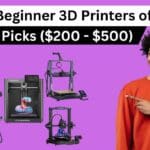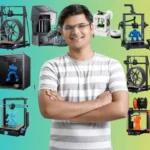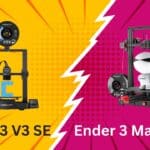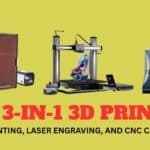
The Creality Ender 3 V3 SE wins for beginners, ELEGOO Mars 5 Ultra excels for detailed resin prints, and FLASHFORGE Adventurer 5M dominates for speed and material versatility.
Ever dreamed of creating custom phone stands, personalized gifts, or even replacement parts without leaving your house? I did too! Getting my first 3D printer unlocked a world of possibilities, saving me time and money. It was like something out of a sci-fi movie – bringing digital designs to life right on my desk.
Affiliate Disclosure
We participate in Amazon affiliate programs, earning fees from qualifying purchases via links at no extra cost to you. It’s how we keep this blog rolling and my 3D printers buzzing with fresh filament for reviews like this one!
In this guide, I’ll share my top picks for the best 3D printers for home use in 2025, based on extensive testing and hands-on experience. As a 3D printing expert who’s tested dozens of models, I know the market can be overwhelming. That’s why I’m here to help you make an informed decision, whether you’re a complete beginner or an experienced maker. You’ll find the perfect printer to unleash your creativity and bring your ideas to life!
Related: Best Beginner 3D Printers of 2025: Affordable Picks Under $500
Key Factors to Consider When Choosing a Best 3D Printers for Home Use
Choosing the right 3D printer for your home involves more than just picking the prettiest one. Here are the critical factors to consider when evaluating a 3D printer for home use:
Ease of Use
Let’s be honest—nobody wants to spend hours wrestling with setup or constantly troubleshooting. Look for a printer with a user-friendly interface, intuitive software, and simple setup. Features like auto-bed leveling and pre-calibrated settings can save you a ton of frustration, especially if you’re just starting out. Think about how easy it is to load filament and whether the calibration process is straightforward.
Print Quality
The whole point is to create awesome stuff, right? You want a printer that produces clean, detailed, and accurate results. Pay attention to the resolution (measured in microns), which determines the level of detail. Also, consider layer height and how it impacts the surface finish. A printer with stable mechanics helps ensure dimensional accuracy. Remember to balance print speed vs. quality—faster isn’t always better!
Reliability
A reliable 3D printer is a joy to own. One that constantly needs tweaking? Not so much. Consider build plate adhesion, the likelihood of nozzle clogging or filament jams, the Mean Time Between Failures (MTBF), the warranty, and what other users say in customer support reviews.
Noise Levels
Unless you want to drive your family crazy, noise levels matter—especially in a home environment. Look for a printer with a low decibel rating, silent stepper motors, or even an enclosure to dampen the sound. Vibration dampening can also make a big difference.
Size & Space Requirements
Think about where you’ll put your printer. A compact design is ideal if you’re tight on space, but don’t forget to consider the build volume (XYZ dimensions)—that’s how big your prints can be. Find a balance between a manageable footprint and a useful build area. Also, think about storage requirements.
Affordability
3D printers range from budget-friendly to seriously expensive. Consider your price range and look for the best value for money. Think about the long-term return on investment and factor in filament costs, too.
Top 3D Printers for Home Use in 2025: Our Expert Recommendations
Alright, let’s get to the good stuff—my top picks for 3D printers for home use in 2025. I’ve personally tested these printers and considered a range of needs and budgets.
1. Creality Ender 3 V3 SE – Best 3D Printer for Beginners
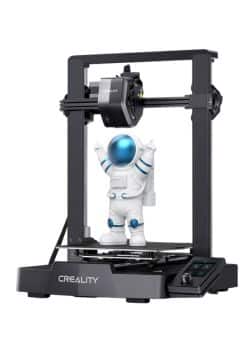
The Creality Ender 3 V3 SE is my top recommendation for anyone just starting out in 3D printing. It’s a fantastic beginner 3D printer that’s affordable and incredibly easy to set up.
Why I Recommend It for Home Use:
The Ender 3 V3 SE is all about simplicity. From its intuitive interface to its straightforward assembly, you’ll be printing your first models in no time. I was particularly impressed with how easy it was to get started—even without prior experience. Plus, its compact size means it won’t take over your entire desk.
Key Features:
- Auto-bed leveling: Say goodbye to frustrating manual adjustments! This feature is a lifesaver for beginners.
- High-speed printing: With a maximum printing speed of 250mm/s, you won’t be waiting forever for your prints to finish.
- “Sprite” direct extruder: Ensures smooth filament feeding and reliable performance with a variety of materials, including PLA filament, TPU, and PETG.
- Dual Z-axis: Provides added stability and precision during printing.
Pros:
✔ Very easy to set up and use—perfect for entry-level 3D printing
✔ Affordable price point (around $219)
✔ Compact design suitable for any home
✔ Reliable customer support (based on my experience and user reviews)
Cons:
✖ Limited build volume—may not be suitable for complex or large-scale projects
✖ May require some minor adjustments for optimal performance
[Check Price and Read More Reviews on Amazon]
2. ELEGOO Mars 5 Ultra – Best Resin 3D Printer for High-Quality Prints

If you’re obsessed with detail and want to create incredibly intricate models, the ELEGOO Mars 5 Ultra is the way to go. This resin 3D printer (also known as an SLA printer) delivers exceptional high-resolution printing that’s perfect for miniatures, jewelry, and detailed prototypes.
Why It Stands Out:
The Mars 5 Ultra’s secret weapon is its 9K resolution LCD screen, which produces stunningly detailed prints with incredibly smooth surfaces. I was blown away by the level of detail I was able to achieve with this printer.
Best Features:
- 9K resolution: Creates incredibly detailed prints with smooth surfaces.
- AI camera: Monitors prints in real-time, alerting you to any errors (a very cool feature!).
- Wi-Fi connectivity: Allows for remote monitoring and easy file transfers.
- Tilt release technology: Speeds up printing by reducing peeling time.
Pros:
✔ Exceptional print quality and detail—ideal for miniatures and complex designs
✔ User-friendly with automatic leveling and self-check features
✔ Quiet operation, which is a big plus for home use
Cons:
✖ Smaller build volume compared to FDM printers
✖ Requires post-processing (cleaning and UV curing) for resin prints
✖ Resin can be a bit messier than filament
[Check Price and Read More Reviews on Amazon]
3. FLASHFORGE Adventurer 5M – Best 3D Printer for Speed and Versatility

Need to churn out prints quickly and experiment with different materials? The FLASHFORGE Adventurer 5M is your answer. This printer is built for high-speed printing and rapid prototyping, making it a great choice for hobbyists and professionals alike.
Why It’s Ideal for Home Use:
The Adventurer 5M combines speed, precision, and ease of use, making it a fantastic option for home users who want to print quickly without sacrificing quality.
Standout Features:
- 600mm/s printing speed: Yes, you read that right! It’s one of the fastest printers on the market.
- CoreXY structure: Ensures stability and precision even at those blazing-fast speeds.
- Direct extruder: Supports a wide range of materials, including PLA, ABS, PETG, and more.
- Real-time app monitoring: Keep an eye on your prints from anywhere with the FlashPrint app.
Pros:
✔ Extremely fast printing speeds
✔ Easy to use with automatic leveling and one-click printing
✔ Versatile material compatibility
Cons:
✖ Noisy operation at high speeds (you might want to put it in a separate room)
✖ Smaller build volume compared to some competitors
[Check Price and Read More Reviews on Amazon]
Quick Comparison Table
To help you make a quick decision, here’s a comparison of the top home 3D printers:
| Printer | Best For | Build Volume | Printing Speed | Key Features | Price |
|---|---|---|---|---|---|
| Creality Ender 3 V3 SE | Beginners | 220 x 220 x 250 mm | Up to 250mm/s | Auto-bed leveling, Direct Extruder | $219 |
| ELEGOO Mars 5 Ultra | High-Quality Resin Prints | 143 x 89 x 175 mm | Fast resin curing | 9K resolution, AI Camera | $350 |
| FLASHFORGE Adventurer 5M | Speed & Versatility | 220 x 220 x 220 mm | Up to 600mm/s | Core XY structure, Direct Extruder | $499 |
Accessories & Upgrades for a Better 3D Printing Experience
Want to take your 3D printing to the next level? Here are some essential accessories and upgrades to consider:
- Filament Dry Box: Keeps your filament dry and prevents moisture absorption, improving print quality.
- Upgraded Bed Springs: Provides more consistent bed leveling and helps prevent warping.
- Nozzle Set: Different nozzle sizes allow you to fine-tune your prints for different levels of detail and speed.
- Enclosure: Reduces noise, maintains a stable printing environment, and filters out fumes (especially important for ABS).
- Print Removal Tools: A flexible spatula makes it much easier to remove prints from the build plate without damaging them.
Related: The Best Filament Dryers for 3D Printing: Top 8 Picks
Related: 10 Must-Have 3D Printer Accessories You Can Buy on Amazon Now
Recommended Filaments:
- PLA Filament: Easy to use, biodegradable, and great for beginners.
- ABS Filament: Strong, durable, and ideal for functional parts (but requires good ventilation).
- PETG Filament: Combines the best of both worlds—the ease of PLA with the strength of ABS.
Related: PLA vs ABS vs PETG: Choosing the Right Filament for Your 3D Prints
Related: 🚀Boost Your 3D Printing with Best FLASHFORGE Filaments of 2025!
FAQs: Common Questions Before You Buy
How much space do I need for a 3D printer?
It depends on the size of the printer. Compact printers like the Ender 3 V3 SE don’t require much space, while larger printers like the Adventurer 5M will need a bit more room.
Are 3D printers safe for home use?
Yes, 3D printers are generally safe when used properly. Ensure good ventilation (especially with resin printers), and always follow the manufacturer’s safety guidelines.
What software do I need for 3D printing?
You’ll need slicing software (like Cura or PrusaSlicer) to convert 3D models into instructions for your printer. You may also want 3D modeling software (like Tinkercad or Fusion 360) to create your own designs.
Where can I find 3D models to print?
There are many online repositories where you can download free and paid 3D models, such as Thingiverse, MyMiniFactory, and Cults3D.
Final Thoughts: Which 3D Printer Should You Choose?
- For Beginners: The Creality Ender 3 V3 SE is the perfect entry point into the world of 3D printing.
- For High-Quality Resin Prints: The ELEGOO Mars 5 Ultra delivers stunning detail and is ideal for miniatures and intricate designs.
- For Speed and Versatility: The FLASHFORGE Adventurer 5M is a powerhouse that can handle a wide range of materials and print at blazing-fast speeds.
No matter which printer you choose, you’ll be amazed by the possibilities of home 3D printing. So, pick the one that fits your needs, click the links below to check the latest prices, and start printing today!



